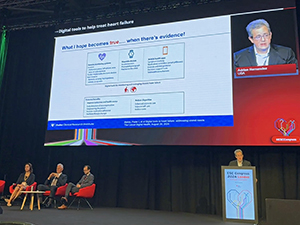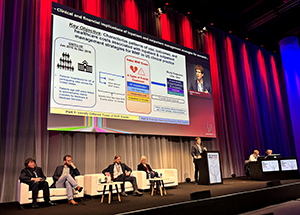
Faculty members and fellows of the Duke Clinical Research Institute (DCRI) shared their expertise during the European Society of Cardiology Congress (ESC) in London, Aug. 30-Sept. 2. Late-breaking trial results presented by DCRI faculty at the meeting offered new insights into drug and device efficacy and capabilities. Meanwhile, others presented studies evaluating different approaches to cardiovascular care, reviewed how new digital tools can improve the quality and geographic reach of patient care, and provided valuable feedback to their colleagues’ presentations while serving as session chairs and discussants.
Late-Breaker Video Highlights from ESC
DCRI Highlights from ESC
Friday, Aug. 30
Delivering Optimal Care for Patients with Obesity During Cardiac Procedures
Specialized equipment and a more tailored approach to imaging are needed to improve outcomes and increase safety for both patients and providers during cardiac procedures in patients with obesity, according to an Aug. 30 afternoon discussion led by DCRI’s Jennifer Rymer, MD, MBA.
Many standard imaging techniques used during heart procedures, which allow operators to visualize blood flow and heart function in real time, involve radiation exposure. Procedures can take more time in patients with obesity, but as that time increases, so does patient and provider exposure to radiation.

“There’s a really significant orthopedic and occupational risk for doing procedures in these patients — more difficult access, more difficult for the operator to position the patient, and there’s way more radiation exposure, which is huge,” said Jennifer Rymer, MD, following the session. “As your radiation creeps up, you can’t do everything you need to do in the procedure because you can’t go over a certain radiation.”
Panelists participating in the discussion suggested alternate imaging options as a viable strategy to avoid the increased risk associated with radiation exposure. They also suggested that health systems invest in improved equipment to block and deflect the radiation, and noted the importance of having candid discussions with the patients before their procedure.
“I think increasingly it’s going to be necessary for operators to have access to what’s called zero-gravity lead, where you’re not wearing lead the whole time, increasing pads that they can put on the patient to deflect the radiation, and just greater conversations with the patients about that as a risk factor for going into the procedure,” Rymer said.
Saturday, Aug. 31
Performance of Apple Watch for Detecting Atrial Fibrillation Among a Known Atrial Fibrillation Population
Many devices that detect irregular heart rhythms — including Apple Watches — are indicated and approved for people who do not have a history of atrial fibrillation (AF) diagnosis, but the devices are nevertheless increasingly used by healthcare providers to help make decisions about patient care in patients with AF.
A study shared by DCRI’s Jonathan Piccini, MD, MHS, in a Saturday afternoon ESC session, explored the performance of the Apple Watch Irregular Rhythm Notification (IRN), comparing it to an implantable cardiac monitor to detect AF in patients with known AF from the DEFINE AFib study. Results suggested that clinicians should exercise caution when interpreting Apple Watch AF data in these patients.

“In patients with a history of atrial fibrillation, the Apple Watch IRN is most sensitive at the individual level. It is less sensitive at the episode level. The current IRN algorithm for the Apple Watch favors long episodes greater than six hours,” Piccini said. “Thus, the limited sensitivity, the user independence, the limited accuracy of the IRN algorithm invites caution when we’re interpreting those data to make clinical decisions for our patients with known atrial fibrillation.”
Piccini noted that if the watch detects an AF episode, the individual wearing it has likely had an episode of AF. However, the watch may not catch every episode.
“For the clinicians, the primary take home bedside message is the data provided by the irregular rhythm notification algorithm has limitations, especially in patients with known atrial fibrillation,” he said. “So, anytime there is a discordance between the symptoms the patient is sharing with you and your suspicion for whether or not they may be experiencing AF progression, it’s really important to validate that with continuous monitoring technology to make sure we have the right answer.”
Certifying Physicians and Allied Professionals in Cardiac Implantable Electronic Device Therapy and Invasive Cardiac Electrophysiology
Following presenters who discussed the training requirements for physicians and allied health professionals in Europe, DCRI’s Sana Al-Katib, MD, MHS, shared the American training requirements, concluding that both approaches to certification and continuing education are fairly similar. Ensuring that the outcomes of those efforts align with their goals of having well-prepared clinicians is important, she said.

“There’s one point that all of us can agree on: that’s basically that clinicians — either medical doctors or allied professionals should be competent enough to care for patients,” Al-Khatib said. “So that’s why you have all these certification and recertification efforts.”
Al-Khatib went on to emphasize the importance of measuring the outcomes of such training measures to be sure that they are adequately preparing clinicians to treat patients.
“I think that it is incredibly important for us as a scientific community to test the impact of all these certification or recertification tools or exams,” she said. “Not every person who aces a test is a very competent clinician.”
Making certification and recertification fun and easy, Al-Khatib continued, could help clinicians feel more prepared and confident.
“Ultimately, it is on us as clinicians to ensure that we feel confident in our knowledge and abilities to do the procedures.”
Sunday, Sept. 1
OCEANIC-AF - Asundexian Versus Apixaban in Patients with Atrial Fibrillation

In a Sept. 1 morning Hot Line presentation, DCRI’s Manesh Patel, MD, shared results from the OCEANIC-AF trial, which demonstrated that 50 mg. of asundexian once daily was inferior to apixaban in preventing stroke and systemic embolism for patients with atrial fibrillation at high risk for stroke.
“Over 14,810 patients with atrial fibrillation at risk for stroke were enrolled over 11 months worldwide. Asundexian 50mg once daily was inferior for the prevention of stroke and systemic embolism compared with apixaban in patients with atrial fibrillation at high risk for stroke,” Patel said.
“Clearly, more research is needed to determine if there is the correct amount of Factor XI inhibition for this indication, atrial fibrillation and stroke prevention.”
Patel served as the executive committee co-chair. Jonathan Piccini, MD, MHS, was the principal investigator and first author of the study’s simultaneous publication in the New England Journal of Medicine.
GUARD-AF - Reducing Stroke by Screening for Undiagnosed Atrial Fibrillation in Elderly Individuals

Wearable, long-term continuous heart monitors helped identify 52% more cases of atrial fibrillation compared to usual care, but that did not lead to a reduction in hospitalizations due to stroke, according to a study led by the DCRI.
The findings, shared Sept. 1 during a main stage Hot Line session and published in the Journal of the American College of Cardiology, provide inconclusive data about whether atrial fibrillation screening lowers stroke rates. The COVID pandemic led to an early halt of the study before fully enrolling, so it did not have enough participants to establish definitive results about stroke.
“Atrial fibrillation is often undiagnosed and can increase the risk of ischemic stroke, which is largely reversible by oral anticoagulation,” said lead author and presenter Renato Lopes, MD, PhD, MHS, a professor of medicine and member of the DCRI.
“We still need definitive evidence that diagnosis of atrial fibrillation through systematic screening can lead to subsequent treatment with oral anticoagulation and, therefore, lower stroke risk,” Lopes said.
Monday, Sept. 2
Digital Tools to Help Treat Heart Failure
Imagine you’re a taxi driver tasked with bringing all the people in London to the ESC Congress in one day, armed only with a taxi and a paper map. This was the challenge issued by DCRI Executive Director Adrian Hernandez, MD, MHS, to his audience during an early morning session on Sept. 2. He likened the challenge to clinicians treating heart failure without leveraging the new digital tools now available to them.
Digital tools available today, such as wearables and implants, can enable more frequent and accurate patient monitoring and management, while also improving detection and management accessibility for those in underserved or rural areas.
Hernandez outlined three key areas to consider where digital tools can make a difference when it comes to heart failure in detection, treatment optimization, and remote monitoring and management.
He shared how the MANAGE-HF study showed a multi-sensor device that monitors patients’ heart activity can alert patients and providers to unseen issues early and, when they have guidelines for next steps to take after getting an alert, they are able to adjust their medical treatment accordingly, resulting in better patient outcomes.

“These alerts are designed to detect sub-clinical heart failure before they have overt heart failure,” Hernandez said. “It’s like if you’re trying to drive through London, and there’s a traffic jam, and you have an alternative route — you would know that through Google Maps, but you wouldn’t necessarily know that with a paper map.”
The patients in the study who were least treated in reaction to the sensor alerts had higher heart failure event rates than the patients who were most treated according to protocols.
Hernandez pointed out DCRI faculty-led studies that identified shortfalls in heart failure management, trials of digital interventions aimed at closing the gap, and how the DCRI is taking the lessons learned from these studies forward toward generating new knowledge in the space with studies like the AIM-POWER study.
Summarizing these lessons learned, Hernandez recommended building better systems and automating where feasible, improving patient engagement and activation and continuously evaluating new technologies.
“What I hope becomes true is that we will have remote monitoring systems, we will have wearable devices, and we will have mobile health apps that can help every patient, every day, and also improve population health,” he said.
Clinical and Financial Implications of Inpatient and Outpatient Management Strategies for Worsening Heart Failure
Managing worsening heart failure (WHF) represents a serious public health and financial burden, and while hospitalization is the predominant management strategy compared with outpatient approaches, overlooking other options could cost both patients and payers.
DCRI’s Stephen Greene, MD, presented study results comparing hospitalization to outpatient strategies for WHF during a Sept. 2 ESC session, providing more clarity into the clinical and financial implications of the different approaches.

“There are high rates of death and substantial reductions in home time following worsening heart failure, regardless of the care setting or management strategy. But the outcomes were worse following heart failure hospitalization,” Greene said. “Outpatient IV diuretic administration was the least expensive initial management strategy, but when you followed patients over the subsequent 12 months, the associated costs of treating patients via the outpatient diuretic visit were similar or perhaps even higher than the costs accrued following heart failure hospitalization.”
The study included more than 180,000 patients hospitalized for heart failure and tracked their outcomes and treatment strategies in the 12 months following their initial hospitalization. Of the patients that experienced a worsening heart failure event — approximately 34% — in the 12-month follow-up period, nearly 80% were hospitalized, 13% were treated via an emergency department visit, 3% in an observation unit stay, and 4% with an outpatient IV diuretic clinic visit.
Greene noted that management of worsening heart failure as an outpatient via the observation unit or IV diuretic clinic visit has increased modestly over time.
“I believe a singular focus on heart failure hospitalization underestimates the frequency, the clinical relevance, and the financial burden of worsening heart failure in routine clinical care,” Greene said. “Further research and quality improvement initiatives are warranted to improve outcomes following outpatient worsening heart failure events without just a singular focus on those that are hospitalizing.”